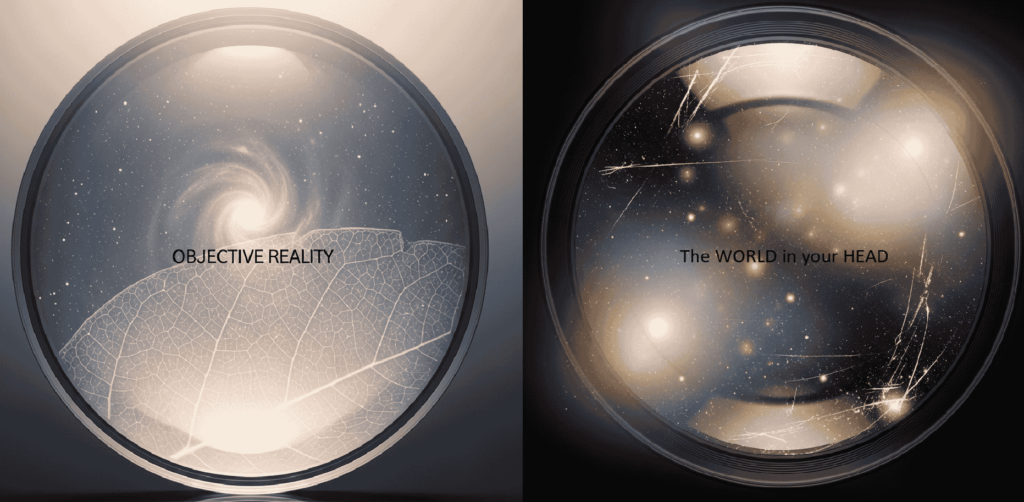Let’s try a little experiment.
Think about a rainy day. Just a plain, ordinary, grey-sky, water-falling-from-the-heavens kind of day. What’s the first feeling that comes to mind?
For one person, a rainy day is a disaster. It’s cancelled plans, gloomy skies, and a general sense of blah. It’s something to be endured.
For another person, that exact same rainy day is a gift. It’s a guilt-free excuse to stay inside, curl up with a book, and listen to the gentle sound of drops on the windowpane. It’s cozy, peaceful, and restorative.
So, which is it? Is a rainy day objectively good or objectively bad?
The obvious answer is, “It’s neither.” But that’s where things get interesting. The rain is real. The water is wet, the clouds are grey. That’s the world “as it is.” But the experience of the rainy day—the gloom or the coziness—doesn’t exist out there in the clouds. It exists in here, inside our heads.
This leads us to one of the quietest, most fundamental questions of the human experience:
Do we see the world as it is, or do we see the world as we are?
It feels like we see the world as it is. It feels like we’re just passive observers, watching the movie of reality on a perfectly clear screen. But we’re not. We’re not watching the movie at all. We’re the projectors.
To get our heads around this, let’s imagine two things.
The Reality Window and Your Personal Lens

First, imagine the Reality Window.
This is what we think we’re looking through. We believe we have a direct, unfiltered feed of the world.
But we don’t. In reality, we each have a Personal Lens.
We don’t see reality directly. We see reality through our unique, custom-built, ever-changing Personal Lens. And we spend so much of our lives convinced that the distorted image we see is the Reality Window.
This lens isn’t clean. It’s been smudged by your past experiences, tinted by your mood, and warped by your beliefs and fears. It has scratches on it from every time you’ve been hurt and glowing spots from every time you’ve been happy. This is the lens you actually look through, and the image it creates is the world you live in.
The Smudges on Your Lens
What are these smudges and tints made of? They’re not random. They’re the building blocks of who you are.
1. The Biological Smudges:
This is the most basic layer. Our senses are just tools, and they have limitations. We can’t see in ultraviolet like a bee, or hear the high-pitched sounds a dog can. Our world is built out of a tiny sliver of the electromagnetic spectrum that our eyes happen to be able to detect. Right from the start, our lens is filtering reality. Our brains are also hardwired to find patterns and create stories, sometimes connecting dots that have no business being connected.
2. The Experience Smudges:
This is the big one. Every single thing that has ever happened to you has left a residue on your lens.
- If you were praised for being quiet and obedient as a child, you might see a loud, assertive person as “rude” or “aggressive.” Someone else might see them as “confident” and “inspiring.”
- If you had your heart broken, you might see a new relationship through a lens tinted with caution and fear.
- If you grew up in a culture that values community above all else, you might see a fiercely individualistic person as “selfish.” Someone from a different culture might see them as “independent.”
3. The Mood Tint:
This is the smudge that changes daily, or even hourly. Let’s call it the Mood Painter.
The Mood Painter decides what color to paint your lens for the day.
- On a “sunny yellow” day, a traffic jam is a chance to listen to more of your favorite podcast. A challenging project at work is an exciting opportunity. The world feels full of potential.
- On a “murky grey” day, that same traffic jam is a personal attack on your schedule. The work project is an overwhelming burden. The world feels full of obstacles.
The traffic is the same. The project is the same. The only thing that changed was the color of your lens.
So, What Do We Do?
If we’re all just walking around looking through our own funhouse mirrors, it can feel a little hopeless. How can we ever know what’s real? How can we ever connect with each other?
The goal isn’t to get a perfectly clean, smudge-free lens. That’s impossible. You can’t erase your biology or your past. Your lens is you.
The goal is to become a Lens Cleaner.
A Lens Cleaner is someone who understands that they have a lens. That’s the first and most important step. It’s the practice of moving from unconscious seeing to conscious observation. It’s about adding a new thought to your internal monologue: “I’m not just seeing the world; I’m seeing the world through my lens.”
This practice gives you three incredible superpowers:
1. Humility: When you know you’re looking through a distorted lens, you become less certain that your version of reality is the only correct one. You realize that the person you’re arguing with isn’t necessarily crazy or evil; they’re just looking at the same world through a different set of smudges. This doesn’t mean there’s no such thing as truth, but it does mean our access to it is always filtered.
2. Self-Awareness: You can start to identify your own smudges. You can learn to ask, “Am I reacting to this situation as it is, or am I reacting to it through my ‘fear of failure’ smudge?” or “Is this person actually being critical, or am I just looking at them through my ‘I’m not good enough’ tint?” This gives you the power to separate your past from your present.
3. Empathy: This is the ultimate power. When you truly understand the lens concept, you can try to imagine what someone else’s lens looks like. You can ask, “What experiences might have created the smudges that are causing them to see the world this way?” This is the beginning of true compassion. It’s the ability to see the world from behind someone else’s eyes.
The world “out there” is a constant. It is what it is. But the world “in here”—the one you actually live in, the one that makes you happy or sad, hopeful or afraid—is something you are constantly co-creating.
The journey of wisdom isn’t about exploring the external world. It’s about understanding the internal one. It’s about turning your attention away from the view and, for the first time, really looking at the lens you’re seeing it through.
What story is your lens telling you about your life, and more importantly, is it the story you want to live?
